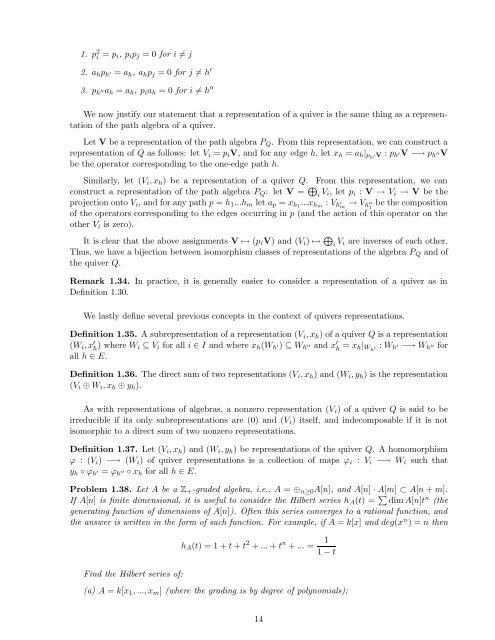Lecture notes for Introduction to Representation Theory
Lecture notes for Introduction to Representation Theory
Lecture notes for Introduction to Representation Theory
You also want an ePaper? Increase the reach of your titles
YUMPU automatically turns print PDFs into web optimized ePapers that Google loves.
1. p 2<br />
i = p i, p i p j = 0 <strong>for</strong> i ⇒ = j<br />
2. a h p h ⊗ = a h , a h p j = 0 <strong>for</strong> j ⇒ = h <br />
3. p h ⊗⊗ a h = a h , p i a h = 0 <strong>for</strong> i ⇒ = h <br />
We now justify our statement that a representation of a quiver is the same thing as a representation<br />
of the path algebra of a quiver.<br />
Let V be a representation of the path algebra P Q . From this representation, we can construct a<br />
representation of Q as follows: let V i = p i V, and <strong>for</strong> any edge h, let x h = a h | ph ⊗ V : p h ⊗ V −⊃ p h ⊗⊗ V<br />
be the opera<strong>to</strong>r corresponding <strong>to</strong> the one-edge path h.<br />
Similarly, let (V i , x h ) be a representation of a quiver Q. From this representation, we can<br />
construct a representation of the path algebra P Q : let V = i V i, let p i : V ⊃ V i ⊃ V be the<br />
projection on<strong>to</strong> V i , and <strong>for</strong> any path p = h 1 ...h m let a p = x h1 ...x hm : V h ⊗ ⊃ V h ⊗⊗ be the composition<br />
m 1<br />
of the opera<strong>to</strong>rs corresponding <strong>to</strong> the edges occurring in p (and the action of this opera<strong>to</strong>r on the<br />
other V i is zero).<br />
It is clear that the above assignments V ⊃ (p i V) and (V i ) ⊃ V i are inverses of each other.<br />
i<br />
Thus, we have a bijection between isomorphism classes of representations of the algebra P Q and of<br />
the quiver Q.<br />
Remark 1.34. In practice, it is generally easier <strong>to</strong> consider a representation of a quiver as in<br />
Definition 1.30.<br />
We lastly define several previous concepts in the context of quivers representations.<br />
Definition 1.35. A subrepresentation of a representation (V i , x h ) of a quiver Q is a representation<br />
(W i , x h ) where W i ∧ V i <strong>for</strong> all i I and where x h (W h ⊗ ) ∧ W h ⊗⊗ and x h = x h| Wh ⊗ : W h ⊗ −⊃ W h ⊗⊗ <strong>for</strong><br />
all h E.<br />
Definition 1.36. The direct sum of two representations (V i , x h ) and (W i , y h ) is the representation<br />
(V i W i , x h y h ).<br />
As with representations of algebras, a nonzero representation (V i ) of a quiver Q is said <strong>to</strong> be<br />
irreducible if its only subrepresentations are (0) and (V i ) itself, and indecomposable if it is not<br />
isomorphic <strong>to</strong> a direct sum of two nonzero representations.<br />
Definition 1.37. Let (V i , x h ) and (W i , y h ) be representations of the quiver Q. A homomorphism<br />
: (V i ) −⊃ (W i ) of quiver representations is a collection of maps i : V i −⊃ W i such that<br />
y h ∞ h ⊗ = h ⊗⊗ ∞ x h <strong>for</strong> all h E.<br />
Problem 1.38. Let A be a Z + -graded algebra, i.e., A = n∧0 A[n], and A[n] · A[m] ⎨<br />
→ A[n + m].<br />
If A[n] is finite dimensional, it is useful <strong>to</strong> consider the Hilbert series h A (t) = dim A[n]t n (the<br />
generating function of dimensions of A[n]). Often this series converges <strong>to</strong> a rational function, and<br />
the answer is written in the <strong>for</strong>m of such function. For example, if A = k[x] and deg(x n ) = n then<br />
Find the Hilbert series of:<br />
h A (t) = 1 + t + t 2 + ... + t n + ... = 1<br />
1 − t<br />
(a) A = k[x 1 , ..., x m ] (where the grading is by degree of polynomials);<br />
14

















